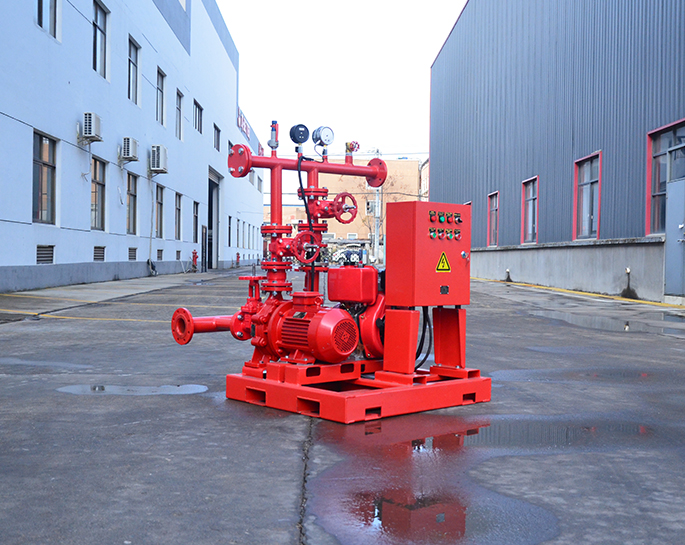What is the role of fire pump flow control valves, and how are they adjusted?
Jan 08, 2024
Share:
Fire pump flow control valves play a crucial role in regulating and controlling the flow of water through the fire protection system. Their primary purpose is to maintain a consistent and controlled flow rate, ensuring that the system meets the required design specifications. These valves are typically installed on the discharge side of fire pumps and are used to manage the pressure and flow in the system. Here's an overview of their role and how they are adjusted:
**Role of Fire Pump Flow Control Valves:**
1. **Maintaining System Pressure:**
- Flow control valves help maintain a steady pressure in the fire protection system. They prevent pressure fluctuations that may occur due to changes in demand or pump operation.
2. **Flow Limitation:**
- Fire pump flow control valves limit the flow rate to prevent excessive water discharge. This is important for ensuring that the system operates within its designed capacity and does not exceed the capabilities of downstream components such as pipes, fittings, and sprinklers.
3. **Preventing Over-Pressurization:**
- These valves play a role in preventing over-pressurization of the system, especially during low-demand periods. Over-pressurization can lead to damage to the system components and may cause water hammer effects.
4. **Adjusting Flow:**
- Flow control valves allow for manual adjustment of the flow rate, which is important for balancing the system and meeting specific design requirements. Adjustments may be necessary during system commissioning or when modifications are made to the system.
**Adjusting Fire Pump Flow Control Valves:**
The adjustment of fire pump flow control valves should be performed by qualified personnel, and it typically involves the following steps:
1. **Identify the Valve:**
- Locate the flow control valve on the discharge side of the fire pump. It is usually positioned after the pump and before the main distribution piping.
2. **Review System Design:**
- Refer to the system design specifications to understand the required flow rates and pressure settings. This information is crucial for adjusting the valve to meet the design criteria.
3. **Use Proper Tools:**
- Adjust the valve using the appropriate tools, such as a wrench or valve key. Some valves may have a handwheel or a nut that can be turned to open or close the valve.
4. **Gradual Adjustments:**
- Make adjustments gradually, monitoring the flow and pressure in the system. It's essential to avoid sudden changes that could lead to water hammer or other undesirable effects.
5. **Perform System Testing:**
- After making adjustments, perform system testing to ensure that the flow rates and pressures meet the design requirements. This may involve activating the fire pump and monitoring the system response.
It's important to note that the adjustment of fire pump flow control valves should be carried out in compliance with local regulations and standards. Additionally, periodic inspections and testing of the fire protection system are recommended to ensure ongoing compliance and reliability. If in doubt or if adjustments are not straightforward, it's advisable to consult with a qualified fire protection professional or engineer.

**Role of Fire Pump Flow Control Valves:**
1. **Maintaining System Pressure:**
- Flow control valves help maintain a steady pressure in the fire protection system. They prevent pressure fluctuations that may occur due to changes in demand or pump operation.
2. **Flow Limitation:**
- Fire pump flow control valves limit the flow rate to prevent excessive water discharge. This is important for ensuring that the system operates within its designed capacity and does not exceed the capabilities of downstream components such as pipes, fittings, and sprinklers.
3. **Preventing Over-Pressurization:**
- These valves play a role in preventing over-pressurization of the system, especially during low-demand periods. Over-pressurization can lead to damage to the system components and may cause water hammer effects.
4. **Adjusting Flow:**
- Flow control valves allow for manual adjustment of the flow rate, which is important for balancing the system and meeting specific design requirements. Adjustments may be necessary during system commissioning or when modifications are made to the system.
**Adjusting Fire Pump Flow Control Valves:**
The adjustment of fire pump flow control valves should be performed by qualified personnel, and it typically involves the following steps:
1. **Identify the Valve:**
- Locate the flow control valve on the discharge side of the fire pump. It is usually positioned after the pump and before the main distribution piping.
2. **Review System Design:**
- Refer to the system design specifications to understand the required flow rates and pressure settings. This information is crucial for adjusting the valve to meet the design criteria.
3. **Use Proper Tools:**
- Adjust the valve using the appropriate tools, such as a wrench or valve key. Some valves may have a handwheel or a nut that can be turned to open or close the valve.
4. **Gradual Adjustments:**
- Make adjustments gradually, monitoring the flow and pressure in the system. It's essential to avoid sudden changes that could lead to water hammer or other undesirable effects.
5. **Perform System Testing:**
- After making adjustments, perform system testing to ensure that the flow rates and pressures meet the design requirements. This may involve activating the fire pump and monitoring the system response.
It's important to note that the adjustment of fire pump flow control valves should be carried out in compliance with local regulations and standards. Additionally, periodic inspections and testing of the fire protection system are recommended to ensure ongoing compliance and reliability. If in doubt or if adjustments are not straightforward, it's advisable to consult with a qualified fire protection professional or engineer.







